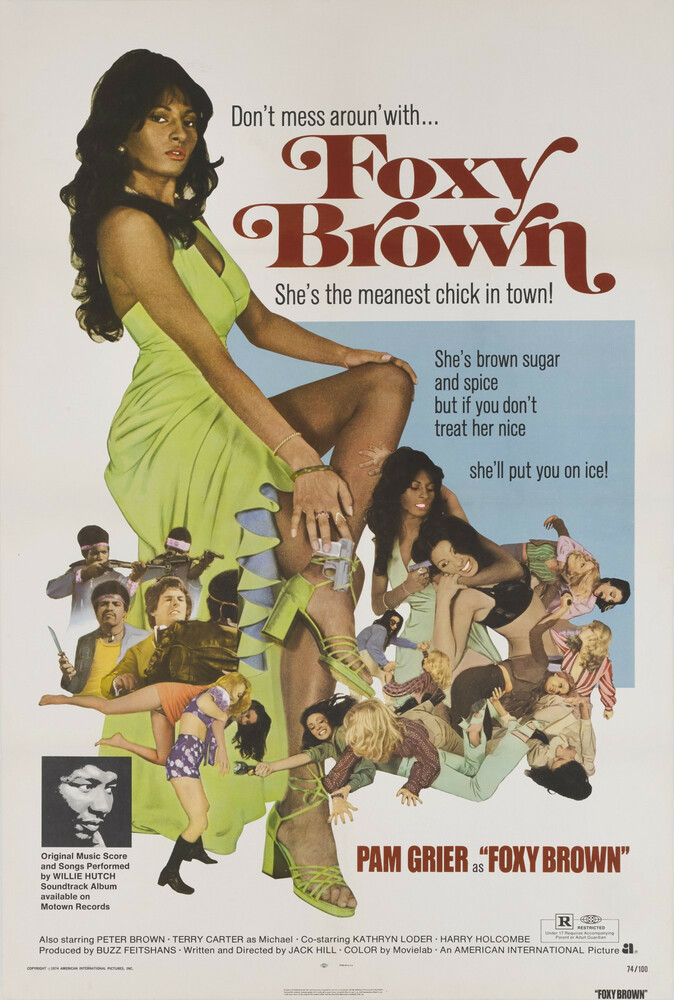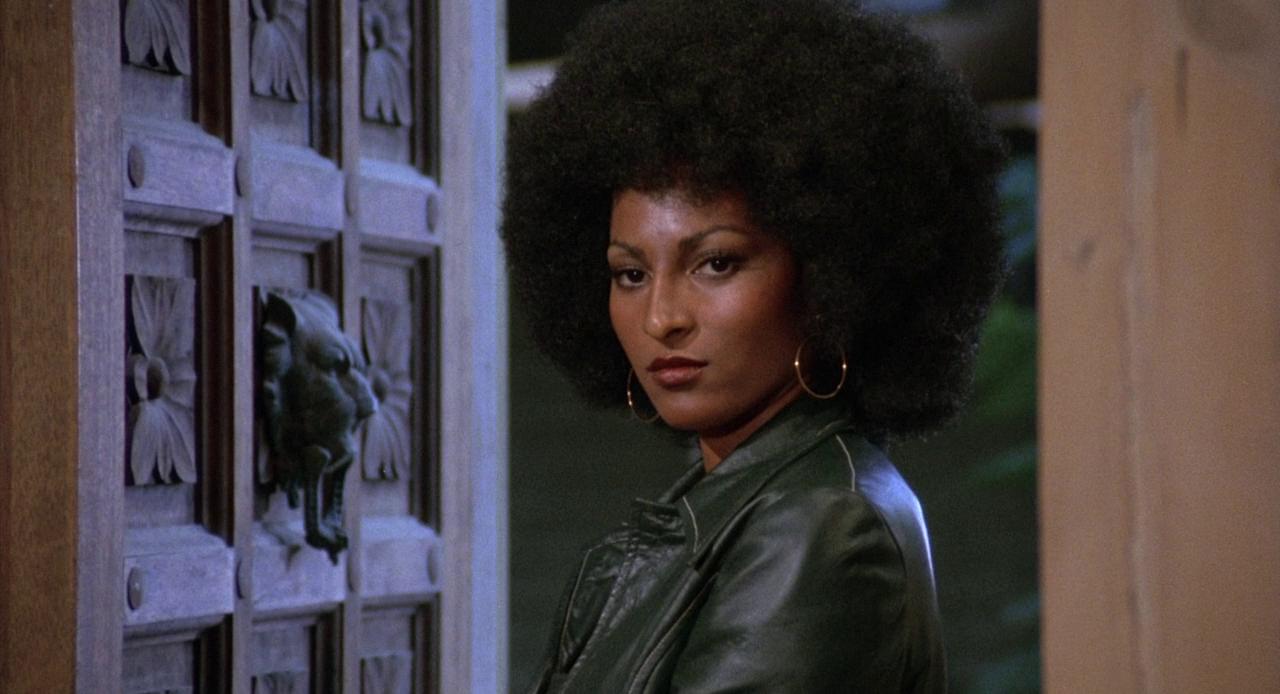Director: Jack Hill
Writers: Jack Hill and David Sheldon
Stars: Pam Grier, Peter Brown, Terry Carter, Kathryn Loder and Harry Holcombe
 |
Index: The First Thirty.
In some ways, Foxy Brown, which started life as a sequel to Coffy titled Burn, Coffy, Burn!, had a bigger impact on film than its predecessor. It’s not a better movie and there are a slew of problems if you think even a little about the details, but it kept the things that worked for its target audience and focused them better to provide a film that would resonate with them even more deeply.
The most obvious detail it kept is the kick-ass female lead played by Pam Grier. This was her twelfth film and it feels like she had been building to these movies all the way through. Just as importantly, it kept the fact that she’s a good girl, even if we aren’t let in on her choice of day job. Coffy was a nurse, a saver of people. Foxy is a little less clear, but she does right by her brother, who doesn’t deserve it, and quite a few others, who do. She does what she does to help people, even if it’s vigilante justice.
What it firmly ditched was any semblance of guilt about doing those things. Coffy did what she felt she must because of her sister, but she agonised over it afterwards. Foxy’s trigger is a boyfriend, who’s murdered by drug dealers on her doorstep, but she never looks back. What she does apparently fails to phase her at all. It simplifies the question. And she does it all in a stylish wardrobe, courtesy of Ruthie West, her personal costumer on the film.
Grier, of course, is excellent, because she’s believable as the sister, girlfriend, community member who cares, but she’s also believable as a lady who will do anything it takes to take the bad guys down. Oddly, it takes a while for her to actually kill anyone in this film, but she gets there, of course, and she’s even colder blooded than that, as we find in a gruesome late scene that presages the finalé of Se7en. What’s in the box, right?
 |
The bad guys are drug dealers again, which was against type for blaxploitation pictures. In this case, however, they’re entirely white. The message in Coffy that all the important people are corrupt, whether they’re white or black, is watered down here so that it becomes decent black folk against criminal white folk.
When a white guy shows up, he’s also a bad guy. It’s a rule. There aren’t many cops here, but the pair in the opening scene completely failing to read the room at a taco stand are just stupid and the pair in a later scene are on the take from the bigshots behind the drug trade. We meet some judges, the collective term for them surely being an orgy, given that they’re eager to sample the girls sent over for them in exchange for leniency for dealers in court.
Whenever a black guy is also a bad guy, he’s lowest level, a stooge for the white guys above him, like her good-for-nothing brother, Link, played to utter perfection by Antonio Fargas. No wonder they hired him for Starsky & Hutch a year later, not that this was close to the only blaxploitation picture in his filmography.
Fargas is delightfully slimy as Link, a dealer who owes his bosses twenty grand for a racket gone wrong and is anxious to find a way back into their good graces. He finds it when Foxy, who’s just saved his ass from a beating and is even letting him stay at her place, brings back a new boyfriend who he figures out is actually her old boyfriend.
 |
He was Dalton Ford, an undercover agent at the Bureau of Narcotics who nailed a two year investigation only for the bad guys to buy out the grand jury and shoot him down. Now, with plastic surgery, he’s Michael Anderson, and he can start his new life looking like Colonel Tigh in Battlestar Galactica. Maybe it’s an upgrade.
Apparently, the changes weren’t big enough because Link works it out quickly and rats him out even quicker in exchange for dropping the debt he owes. Now, take a wild stab in the dark at what Foxy thinks of that once she realises!
And so we’re off and running. Foxy wants revenge for Dalton/Michael and she’ll stop at nothing to get it, starting with landing a gig at the escort service fronting as a model agency that persuades judges and juries to help out a select few drug dealers in court in exchange for a lot of very personal attention.
Anyone following this First Thirty will see a recognisable face in Miss Katherine, the lady behind not just the agency but the whole drug racket in town. The big bad guy, Stevie Elias, is her right hand man. Peter Brown is new and believable in the role for someone primarily known as a good guy, playing officers of the law on TV in westerns like Lawman and Laredo. She’s Kathryn Loder, so memorable as Lucian, the butch lesbian head guard with a torture fetish in The Big Doll House.
 |
The other recognisable face here belongs to Sid Haig, because he’s almost inevitable at this point in Pam Grier movies, because they were so great opposite each other. He has a smaller role here, as a pilot who flies drugs in for Miss Katherine from Mexico. Foxy needs to seduce him into letting her onto one of those flights and the result is another memorable couple of scenes for Grier and Haig, who has a real habit of stealing every scene he’s in. Everyone else lets him. Grier doesn’t.
The other scenestealer here is Jeannie Epper who’s best known as a stuntwoman, for which she has a Lifetime Achievement Award at the World Stunt Awards. Here, she’s Bobbie, who attempts to stop Foxy retrieving a model she’s rescued from the syndicate after she stops in at a dyke bar for an unwise drink. She says she has a black belt in karate, so Foxy resorts to using the furniture. “And I got my black belt in barstools!” Epper doesn’t get a lot of time here but she sparks a glorious scene that seems a little unusual for the time.
Perhaps more usual, but maybe not, is social commentary about the streets. Sure, some of it is the usual blaxploitation spin, like Link’s line about ambition, which is very well delivered but nothing new. I was more surprised to see a focus on a “neighbourhood community” group that’s all black but keeping their streets free of drugs. They get their hands plenty dirty by the end, but they’re clearly the good guys, just like Foxy is clearly the good guy.
And just in case we want to pass judgement on that, it’s covered. “Vigilante justice?” asks Michael Anderson. “It’s as American as apple pie,” Foxy replies and it’s in a purer, simpler form here than in Coffy. Maybe that’s why it’s lasted so well. Coffy is the better film but Foxy Brown is the better archetype.






No comments:
Post a Comment